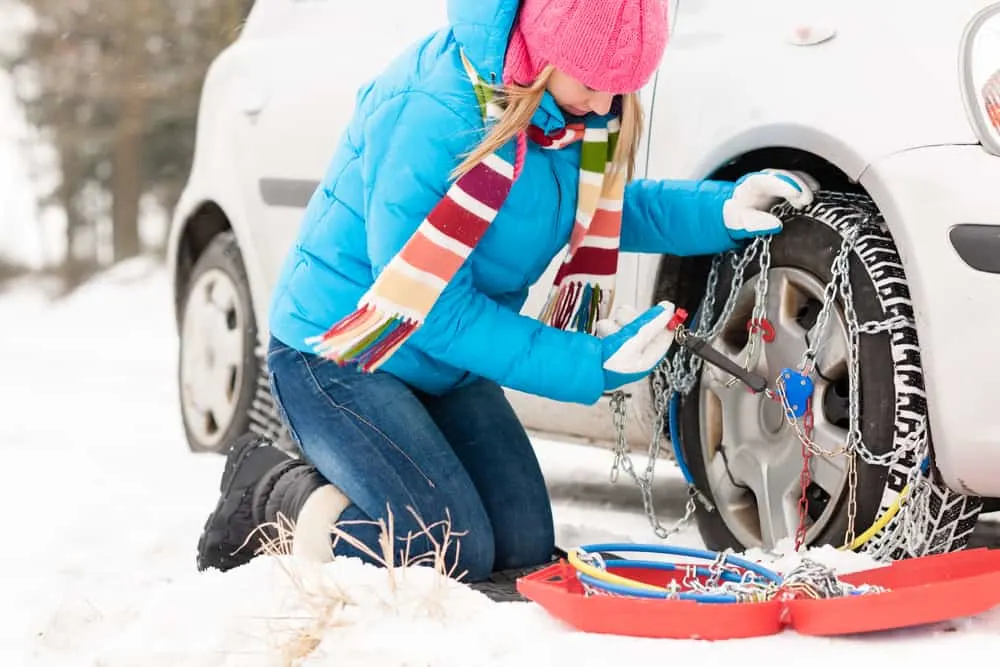If you are getting your vehicle ready for winter, you might be wondering what is the best way to keep your car on the road during heavy snowfall. Driving on snow and ice unprepared can be dangerous and potentially life-threatening. One popular tool utilized by drivers during snowy conditions are snow chains. But are snow chains worth it? Or are there better ways to stop your car sliding around in the snow? Read on to find out about snow chains and possible alternatives.

What are snow chains?
Snow chains are a tool used to increase grip on roads during winter. Snow chains are usually made from a steel alloy, so they don not break under a vehicle’s weight. They can be both studded and unstudded, with studded chains providing additional grip. You will need to apply snow chains to all your car’s drive wheels to provide appropriate traction. For example, if your car has a rear-wheel drive transmission, put snow chains on the back tires.
Here’s how to determine if you need snow chains on all four tires.
Snow chains wrap around your wheels and come in a variety of different styles and patterns. Not all snow chains are the same, though. Four of the most common patterns are:
- Diamond
- Diagonal
- Ladder
- Square
Each pattern improves your automobile’s performance in different ways. For example, a ladder pattern is ideal for off-road driving, while diagonal chains are best-suited to vehicles with traction-control systems.
Some snow chains are made from cables rather than chain links, like Security Chain’s Super Z LT chains. Chains made from cables are great for low-profile vehicles and also provide excellent traction.
Commonly, snow chains have either a self-tensioning or manual-tensioning installation system. With self-tensioning snow chains, you just need to drive forward a few feet with the snow chains underneath your wheels, and the snow chains will tighten. Manual-tensioning snow chains require you to feed any slack through a ratchet in order to keep the snow chain in place, which can be fiddly and time-consuming in freezing cold conditions.
Pros
Improves traction on snow, ice, and mud
The most obvious way that snow chains are beneficial is they provide increased traction on snow and ice. Many snow chains also come in handy on muddy dirt roads, so they will come in handy year-round.
Superior performance to alternatives
Snow chains are generally considered to provide superior traction to alternatives such as snow socks and snow tires. Snow socks tend to work well on compact snow but aren’t very useful on ice or mud. Snow tires are useful on snow and ice but are difficult to remove and may not be suitable for all road surfaces.
Less expensive than alternatives
If you have to drive in snow frequently, snow chains are more affordable than other devices. There are plenty of reasonably priced snow chains available on the market, such as Konig’s CB-12 020 Snow Chains. By comparison, you could end up spending hundreds if not thousands of dollars on a set of snow tires or a winch for your truck.
Cons
Snow chains can be difficult to install
Nobody wants to be stuck outside during a blizzard attempting to untangle and attach snow chains to their tires. Snow chains will often become tangled together, so ensure you store them properly to avoid wasting time.
Also, they can be tough to install and remove, especially manual-tensioning snow chains. So, if you are planning on buying a set of snow chains, consider something with easy installation and removal. An excellent example is Peerless’s 0232805 model snow chains, which have a self-tightening rachet system.
Snow chains could damage your car and the road
Once you have installed your snow chains, you will want to be careful where you use them. On sheets of ice and blankets of snow, snow chains can be particularly useful, but driving on dry roads can potentially ruin the road’s surface and damage your vehicle’s wheels and suspension.
You will also need to ensure your car has the right clearance for your snow chains, especially if you have low profile tires. If your snow chains come into contact with your wheel arch while driving, it could do severe damage to your automobile, as well as damaging your tires.
Low quality snow chains could snap
Low quality snow chains, especially when used on dry or icy roads, can snap, leaving you high and dry in the middle of a snowstorm. When picking out a pair of snow chains, always look at customer reviews to see if they have a history of snapping. Cable chains, such as Glacier’s 1042 model snow chains, tend to be stronger than standard snow chains while still being affordable.
Alternatives
In general, snow chains are worth getting if you live in an area that gets a lot of snow each year. However, if you are not keen on buying yourself some snow chains, here are a few alternatives to consider.
Snow socks
Snow socks are similar to snow chains and have become more popular in recent history. These fabric socks slip over your tires, providing additional traction. While snow socks are generally easier to install, they do not provide anywhere near as much grip as snow chains. Snow socks are probably best suited to light coverings of snow and aren’t much use on ice.
Here is a helpful comparison between snow socks vs snow chains.
Snow tires
Snow tires are one of the most utilized tools for cars on snowy roads. The tread on snow tires is wider than it is on standard tires, giving your car more traction. However, snow tires are pricey and difficult to remove. Some snow tires are also illegal on regular roads, but these laws differ from country to country.
Here is a handy comparison between winter tires vs snow chains.
Winch
Installing a winch system on your vehicle is guaranteed to pull you out of snow if you get stuck. Just wrap the wire from the winch around a sturdy nearby object, and the winch will pull you out. That being said, winches aren’t practical to use for day to day activities and tend to be the most expensive alternative to snow chains.
Grit
Grit or rock salt is the most common way of removing snow and ice from roads. If you have a light covering of snow or the temperature drops below freezing, put out some rock salt to stop your driveway from freezing over. While grit and rock salt helps with light snowfall, it is not much good in a heavy blizzard. It is also not practical to deposit rock salt by hand on country roads without a salt spreader.

